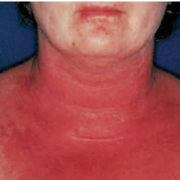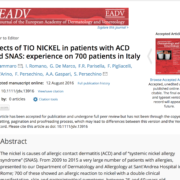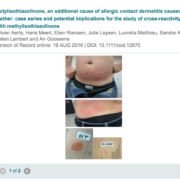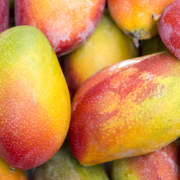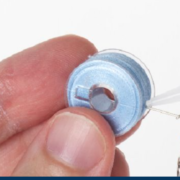This article from King Chulalongkorn Memorial Hospital in Thailand compares the authors patch test result between current (2012-2015) and their prior report (2003-2004). The authors named MCI-MI an “outstanding emerging causative allergen” in their current clinical experience and found MCI-MI to be the most common preservative causing contact allergy (formaldehyde is second). The MCI-MI prevalence was found to be related to personal care products. Also of importance, the prevalence of paraben (another preservative) allergen dropped possibly related to decreased exposure and decreased use in products.
Patterns and risk factors of causative contact allergens in Thai adult patients with contact dermatitis at King Chulalongkorn Memorial Hospital. Dararattanaroj W1, Pootongkam S, Rojanawatsirivej N, Wongpiyabovorn J. Asian Pac J Allergy Immunol. 2016 Jun 30. doi: 10.12932/AP0757.
“BACKGROUND:
Surveillance on common allergens identified by patch testing plays an important role in emerging allergen detection, which leads to both individual and societal level prevention.
OBJECTIVE:
To study the changes in the pattern of contact sensitization and to identify risk factors associated with allergens.
METHOD:
The data of 206 patients who underwent patch testing at King Chulalongkorn Memorial Hospital during 2012 to 2015 were assessed. The associations between patient risk factors and positive reactions to each allergen were evaluated. The results were compared with data from 2003-2004.
RESULTS:
The top five most common allergens during 2012-2015 were nickel sulfate (19.4%), methylchloroisothiazolinone/ methylisothiazolinone (MCI/MI) (13.6%), fragrance mix I (FM I) (10.7%), carba mix (9.2%) and cobalt chloride (6.3%) whereas, during 2003-2004, these were nickel sulfate, cobalt chloride, FM I, potassium dichromate and Myroxylon pereirae. A positive patch test to nickel was strongly associated with a history of metal and seafood allergy (p±0.001; OR, 4.94; 95% CI = 2.33-10.47 and p=0.028; OR, 2.55; 95% CI, 1.11-5.85, respectively). MCI/MI was correlated with a history of personal care products allergy, and fragrance was correlated with a history of urticaria (p=0.005; OR, 4.05; 95% CI = 1.54-10.66 and p=0.031; OR, 2.71; 95% CI, 1.10-6.68, respectively).
CONCLUSIONS:
There was an alteration in the pattern of contact sensitization detected by our standard series. MCI/MI has become the most common preservative causing contact allergy.”
Link here to read the full OPEN ACCESS article:
http://thailand.digitaljournals.org/index.php/APJAI/article/viewFile/29955/30258
To learn more about the second methylisothiazolinone epidemic – click here:
https://www.dermatitisacademy.com/wp-content/uploads/2016/05/Update-on-Isothiazolinones.pdf
Also:
Bunyavaree M1, Kasemsarn P1, Boonchai W1. Cosmetic preservative labelling on the Thai market.
Contact Dermatitis. 2016 Apr;74(4):217-21. doi: 10.1111/cod.12520. Epub 2016 Jan 22.
” International brand cosmetics were more likely to contain non-formaldehyde-releasing preservatives than domestically produced brands. Isothiazolinone-based preservatives, which are responsible for the current increase in the prevalence of contact allergy, were found at a significant frequency in domestically produced, leave-on cosmetic products.”

